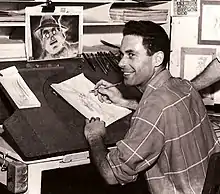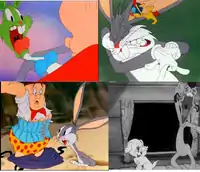Rod Scribner
Roderick H. Scribner (October 10, 1910 – December 21, 1976) was an American animator best known for his work on the Looney Tunes and Merrie Melodies series of cartoons from Warner Bros. Cartoons. He worked during the Golden age of American animation.
Rod Scribner | |
|---|---|
 Scribner, January 1945 | |
| Born | Roderick H. Scribner October 10, 1910 Joseph, Oregon, U.S. |
| Died | December 21, 1976 (aged 66) Buena Park, California, U.S. |
| Occupation | animator |
| Years active | 1935–1975 |
| Spouse(s) | Jane Bannister Kiesner
(m. 1938) |
| Children | 3[2] |
Early life
Scribner had an interest in drawing in high school. Drawing was one of his subjects (along with English and political science) when he attended Denison University for three years. Later, after an interlude spent as an manager of an "hunting marsh", he studied art in Toledo, Ohio, and at the Chouinard Art Institute before he joined the Schlesinger animation staff.[3]
Career
Rod Scribner started as an assistant animator for Friz Freleng in 1935, then a main animator for Ben Hardaway and Cal Dalton in 1938, and also briefly animated for Chuck Jones the next year. In 1940, he joined Tex Avery's unit and worked with Robert McKimson, Charles McKimson, Virgil Ross, and Sid Sutherland.[4][5][6]
In late 1941, after Tex Avery left to direct Speaking of Animals series for Jerry Fairbank Productions, he was replaced as the unit director by Bob Clampett. Scribner's animation matched Clampett's expansive and energetic cartoons. Clampett classics such as A Tale of Two Kitties (1942), Coal Black and de Sebben Dwarfs (1943), and The Great Piggy Bank Robbery (1946) showcase some of his trademark "Lichty style" of animation, which he proposed to Clampett. Clampett left Warner Bros. in 1945 to pursue a career in puppetry and television. Not much is known about where Scribner was between 1946 and 1949 (although he did some animation on three McKimson cartoons starring Porky, Daffy and an elephant named Bobo in 1947).[4][5][7]
He briefly was a cartoonist on Happy Comic's Rowdy Runner and a January 1945 issue of a military magazine called "Service Ribbin".[4]
In 1950, Scribner returned to Warner Bros. under Robert McKimson's unit. His animation was tamed down to McKimson's standards, but he still got away with energetic scenes, like in Hillbilly Hare (1950), Hoppy Go Lucky (1952) and Of Rice and Hen (1953).[8][9]
According to Warner Brothers animator Lloyd Turner in an interview, Scribner was irresponsible at McKimson's unit and was thoroughly crazy. Turner says Scribner did a lot of weird things including burning his house down, and that he had a disdain towards his colleague Arthur Davis, although it is unknown why but it is presumably because Davis replaced Clampett after his departure. Scribner played a lot of pranks on Davis at McKimson's unit, and one time while Davis was in John W. Burton's and on a telephone line in a phone booth, Scribner elbowed Turner and said to him, "Watch me fix Davis". Scribner went on the other side of the booth and tipped the telephone into a 45 degree angle and it boomed like a bomb. Davis was scared, Scribner tipped the phone back, and Scribner ran and, according to Turner "laughed like he was possessed". When Davis saw him running out, he got mad.[10]
He left Warners in 1954 and worked for UPA, Jay Ward, and Storyboard Inc. from the 50's to the mid 60's.[11] When Scribner went to work at Bakshi Studios, he sat down with Bakshi and said to him, "Ralph, I can't do this anymore. I love what you're doing, and this is going to be the greatest studio in the world, but I just can't do it anymore." He cried while he was speaking and handed his scene in. Bakshi recalled the scene looking "absolutely hideous" and looking like something was wrong with him, which ironically, there was. Although Scribner was credited, most of his animation were thrown out or overhauled.[12][13] In his later years, Scribner worked with former colleague Bill Melendez on various Charlie Brown movies and television specials that worked in Snoopy Come Home (1972), There's No Time for Love, Charlie Brown (1973) and It's the Easter Beagle, Charlie Brown (1974), eventually starting at an studio called Playhouse Pictures, which produced commercials for over 45 years.[14][15] The only thing he didn't do for UPA or his former colleague Melendez is an 1968 training video for IBM called A Computer Glossary.[16][17]
Death and legacy

After being arrested and put on suicide watch in a mental hospital, Scribner died there on December 21, 1976 from tuberculosis, which he had contracted during World War II. His last project was Race For Your Life, Charlie Brown, released posthumously in Summer 1977.[18][14] Bill Plympton says his work on Coal Black "is a masterpiece of animation and distortion" and that the animation in the Clampett cartoons blew his mind.[19][20] Cartoon Brew puts him on Number 18 on the list of "25 Great Cartoonists You Should Know"[21] John Kricfalusi is a "Scribner fanatic" and is the reason why he has a despise for Disney animation.[22][23][24]
Partial filmography
Warner Bros.
- A Tale of Two Kitties
- Hare Ribbin'
- All This and Rabbit Stew
- A Corny Concerto
- The Great Piggy Bank Robbery
- Private Snafu
- Of Rice of Hen
- The Night Watchman[25]
- Falling Hare
- Gruesome Twosome
- Russian Rhapsody
- Draftee Daffy
- A Wild Hare
- The Prize Pest
- Quack Shot
- An Itch in Time
- Porky's Hare Hunt
- A-Lad-In Bagdad
- Tortoise Wins by a Hare
- Bars and Stripes Forever
- Nutty News[26]
Commercials
Bakshi Productions
Peanuts
- Race For Your Life, Charlie Brown
- Snoopy Come Home
References
- https://ancestors.familysearch.org/en/L8QK-7HG/roderick-h.-scribner-1911-1976
- Rods Family Tree
- "Rod Scribner at Work". MichaelBarrier.com. 2007-12-20. Retrieved 2020-09-13.
- Irv Spence and Rod Scribner, One-Shot Moonlighters
- Barrier, Michael (1999). Hollywood cartoons : American animation in its golden age. Oxford University Press. p. 436.
- Hartley, Steven (2013-11-02). "Likely Looney, Mostly Merrie: 309. Of Fox and Hounds (1940)". Likely Looney, Mostly Merrie. Retrieved 2020-09-18.
- In His Own Words: Bob Clampett at Warners
- Robert McKimson’s “Of Rice and Hen” (1953)
- Robert McKimson’s “Hillbilly Hare” (1950)
- "Lloyd Turner: An Interview by Michael Barrier". MichaelBarrier.com. Retrieved 2020-09-13.
- Commercials Animated By Rod Scribner
- Anders, Jason (November 2009). "A Conversation with Ralph Bakshi". Fulle Circle Magazine. Retrieved September 16, 2020.
- Thad Komorowski
- http://dmgermain.blogspot.com/2006/03/rod-scribner.html
- Playhouse Potpurri
- https://mubi.com/films/a-computer-glossary
- A Computer Glossary
- http://www.toonzone.net/forums/threads/question-about-rod-scribner.3657641/
- On Animation: The Directors Perspective pg. 351
- Making Toons That Sell Without Selling pg. 111
- 25 Great Cartoonists You Should Know
- An Exchange with John K.
- Goodman, Martin (September 1, 2004). ""When Cartoons Were Cartoony:" John Kricfalusi Presents". Animation World Network. Retrieved September 14, 2020.
- A Story of Rod Scribner
- Chuck Jones’ “The Night Watchman” (1938)
- "Rod Scribner animation Nutty News part 1 - GIF on Imgur". Retrieved 21 January 2021.
- "1965 Bugs Bunny commercial by Tex Avery & Rod Scribner". December 29, 2010. Retrieved August 19, 2020.
- Bugs Bunny Kool-Aid Commercial
External links
- Rod Scribner at IMDb
- A letter concerning the circumstances a few years before his death.